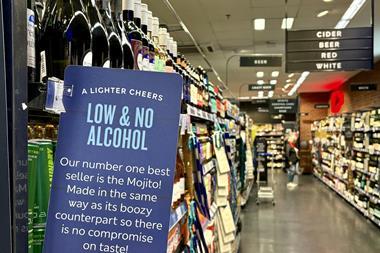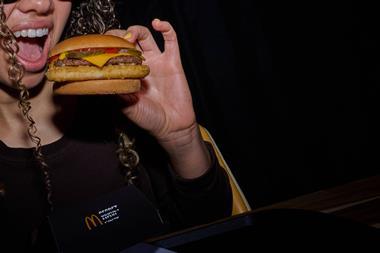Take two ad campaigns. One is a high-budget affair featuring three Guinness drinkers who "evolve" into slimey newt-like prehistoric creatures.
The other, also for Diageo coincidentally, is an equally arty big budget campaign featuring Arctic character Uri giving the viewer a guided tour of his home before showing off his "fridge" - stepping outside into the snow to join his friend Gorb for a Smirnoff Ice.
While the first ad has not attracted any criticism, the other has come under fire from the advertising watchdogs for appealing too overtly to youth culture. Go figure.
How to interpret the new alcohol advertising regime has got a lot of people in the industry - including Diageo - scratching their heads. A year since the regulations were tightened, the whole industry is trying to work out what will pass muster.
Opinion seems to be polarising. Some are plumping for the artistically surreal approach favoured in the Guinness campaigns, others for variations on the bottle- shot theme. But it is easy to get it wrong - and things could be about to get worse. As the industry is scrutinised for its compliance to the code of practice, it faces the threat of a total ban of the sort that hit tobacco.
The alcohol advertising rules were tightened last October in response to government and public concern about binge and underage drinking. Ads can't appeal to youth culture, particularly through the use of celebrities or animated characters, and they can't show anti-social behaviour or be linked to sexual or social success.
A number of alcohol producers have already faced the wrath of the Advertising Standards Authority and its stricter approach.
So how likely is it that we will see the sort of draconian measures applied to tobacco? Alcohol producers say they are complying with the code and the prospect of a total ban is unlikely. "We won't go down that route because we are playing ball," says Richard Clarke, Halewood International's marketing controller.
Many question what purpose a ban would serve. Sweden, for instance, increased taxation on alcohol and stopped producers advertising, yet little difference has been recorded in statistics citing the levels of alcohol harm, according to Kate Blakeley, Diageo GB's head of social responsibility.
"Banning advertising will only make people change brands. It won't stop people drinking," she says. "The industry has to prove it can self-regulate responsibly and the government understands that."
At the moment, producers feel they are doing a good job of keeping a ban at bay. But with all these problem areas to avoid, is there a danger advertisers will be reduced to showing bland product shots?
The ASA says its clampdown on those who don't adhere to the code isn't meant to take away a producer's ability to develop a brand's personality. "The ASA isn't here to take everyone's fun away," says a spokesman. "It should encourage people to be more innovative and creative."
Indeed, the challenge of having to create innovative adverts isn't new to alcohol producers. Most of Diageo's Guinness adverts already eschew direct references to alcohol, showing that thinking outside the box seems to be working.
Then again for many years the tobacco industry was shunted into a similar creative corner. And look where that compromise ended.
Humour, of the sort that has underpinned campaigns for brands such as Lambrini and WKD in the past is definitely a no-no. "You have to be very careful with humour," says Debs Carter, brand controller at Beverage Brands, which owns the WKD brand. "It is hard to develop something that only adults find funny. It has been a challenge, but we are absolutely delighted with our ads now."
The company was pulled up earlier this year for its WKD ads, which were felt to appeal to youngsters because of their practical joke theme. But Carter insists the adverts had reached their natural end and a new campaign that fully complies with the regulations is under way.
Halewood International, the producer of Lambrini, also got a rap on the knuckles in 2005 - before the tighter rules came into effect. The brand came under fire for a poster featuring three women using a hook to ensnare a young man, above the strapline 'Lambrini girls just wanna have fun'.
At the time Halewood was told by the Committee of Advertising Practice that the man in the picture should be unattractive. "Overweight, middle-aged and balding," it suggested. The producer changed its poster accordingly, but at the time chairman John Halewood reacted by saying: "The agency makes some very understandable rulings but we're not sure they're qualified to decide for the nation who's sexy and who's not."
Thankfully the updated code has tightened the debate around interpretation, but it is a delicate balance, says Wilson. In most cases, the copy advice team, which gives ads the all-clear before they are released, tend to spot potential problem areas before the campaigns air. However, the public has a mind of its own. "There has to be a complaints system, but where it's out in the public domain it is difficult," adds Wilson.
And even with the best copy advice team in the world, things can still go wrong. Diageo's Smirnoff Ice TV campaign was pulled up by the ASA this year after the Broadcast Committee of Advertising Practice raised concerns about their possible appeal to young people. Diageo maintained that the music should have no youth appeal in the UK because the band Quarashi was unknown outside Iceland. It also said the fictional characters of Uri and Gorb were not celebrities and led a "distinctly unglamourous lifestyle".
"We were disappointed with the rulings and still don't agree that the ads have any youth appeal," says Blakeley. As a result, Diageo is following the formal complaints procedure.
Meanwhile, like its peers, it continues to try to second-guess what will pass muster and to hope that the new regime won't signal the end of innovative ads. "There have to be some good, consistent decisions," says Blakeley. "In a worst case scenario, advertisers will question whether they can put investment into campaigns."
If this happens, we'll be back to product shots only. Or maybe no ads at all.n
The other, also for Diageo coincidentally, is an equally arty big budget campaign featuring Arctic character Uri giving the viewer a guided tour of his home before showing off his "fridge" - stepping outside into the snow to join his friend Gorb for a Smirnoff Ice.
While the first ad has not attracted any criticism, the other has come under fire from the advertising watchdogs for appealing too overtly to youth culture. Go figure.
How to interpret the new alcohol advertising regime has got a lot of people in the industry - including Diageo - scratching their heads. A year since the regulations were tightened, the whole industry is trying to work out what will pass muster.
Opinion seems to be polarising. Some are plumping for the artistically surreal approach favoured in the Guinness campaigns, others for variations on the bottle- shot theme. But it is easy to get it wrong - and things could be about to get worse. As the industry is scrutinised for its compliance to the code of practice, it faces the threat of a total ban of the sort that hit tobacco.
The alcohol advertising rules were tightened last October in response to government and public concern about binge and underage drinking. Ads can't appeal to youth culture, particularly through the use of celebrities or animated characters, and they can't show anti-social behaviour or be linked to sexual or social success.
A number of alcohol producers have already faced the wrath of the Advertising Standards Authority and its stricter approach.
So how likely is it that we will see the sort of draconian measures applied to tobacco? Alcohol producers say they are complying with the code and the prospect of a total ban is unlikely. "We won't go down that route because we are playing ball," says Richard Clarke, Halewood International's marketing controller.
Many question what purpose a ban would serve. Sweden, for instance, increased taxation on alcohol and stopped producers advertising, yet little difference has been recorded in statistics citing the levels of alcohol harm, according to Kate Blakeley, Diageo GB's head of social responsibility.
"Banning advertising will only make people change brands. It won't stop people drinking," she says. "The industry has to prove it can self-regulate responsibly and the government understands that."
At the moment, producers feel they are doing a good job of keeping a ban at bay. But with all these problem areas to avoid, is there a danger advertisers will be reduced to showing bland product shots?
The ASA says its clampdown on those who don't adhere to the code isn't meant to take away a producer's ability to develop a brand's personality. "The ASA isn't here to take everyone's fun away," says a spokesman. "It should encourage people to be more innovative and creative."
Indeed, the challenge of having to create innovative adverts isn't new to alcohol producers. Most of Diageo's Guinness adverts already eschew direct references to alcohol, showing that thinking outside the box seems to be working.
Then again for many years the tobacco industry was shunted into a similar creative corner. And look where that compromise ended.
Humour, of the sort that has underpinned campaigns for brands such as Lambrini and WKD in the past is definitely a no-no. "You have to be very careful with humour," says Debs Carter, brand controller at Beverage Brands, which owns the WKD brand. "It is hard to develop something that only adults find funny. It has been a challenge, but we are absolutely delighted with our ads now."
The company was pulled up earlier this year for its WKD ads, which were felt to appeal to youngsters because of their practical joke theme. But Carter insists the adverts had reached their natural end and a new campaign that fully complies with the regulations is under way.
Halewood International, the producer of Lambrini, also got a rap on the knuckles in 2005 - before the tighter rules came into effect. The brand came under fire for a poster featuring three women using a hook to ensnare a young man, above the strapline 'Lambrini girls just wanna have fun'.
At the time Halewood was told by the Committee of Advertising Practice that the man in the picture should be unattractive. "Overweight, middle-aged and balding," it suggested. The producer changed its poster accordingly, but at the time chairman John Halewood reacted by saying: "The agency makes some very understandable rulings but we're not sure they're qualified to decide for the nation who's sexy and who's not."
Thankfully the updated code has tightened the debate around interpretation, but it is a delicate balance, says Wilson. In most cases, the copy advice team, which gives ads the all-clear before they are released, tend to spot potential problem areas before the campaigns air. However, the public has a mind of its own. "There has to be a complaints system, but where it's out in the public domain it is difficult," adds Wilson.
And even with the best copy advice team in the world, things can still go wrong. Diageo's Smirnoff Ice TV campaign was pulled up by the ASA this year after the Broadcast Committee of Advertising Practice raised concerns about their possible appeal to young people. Diageo maintained that the music should have no youth appeal in the UK because the band Quarashi was unknown outside Iceland. It also said the fictional characters of Uri and Gorb were not celebrities and led a "distinctly unglamourous lifestyle".
"We were disappointed with the rulings and still don't agree that the ads have any youth appeal," says Blakeley. As a result, Diageo is following the formal complaints procedure.
Meanwhile, like its peers, it continues to try to second-guess what will pass muster and to hope that the new regime won't signal the end of innovative ads. "There have to be some good, consistent decisions," says Blakeley. "In a worst case scenario, advertisers will question whether they can put investment into campaigns."
If this happens, we'll be back to product shots only. Or maybe no ads at all.n



















No comments yet